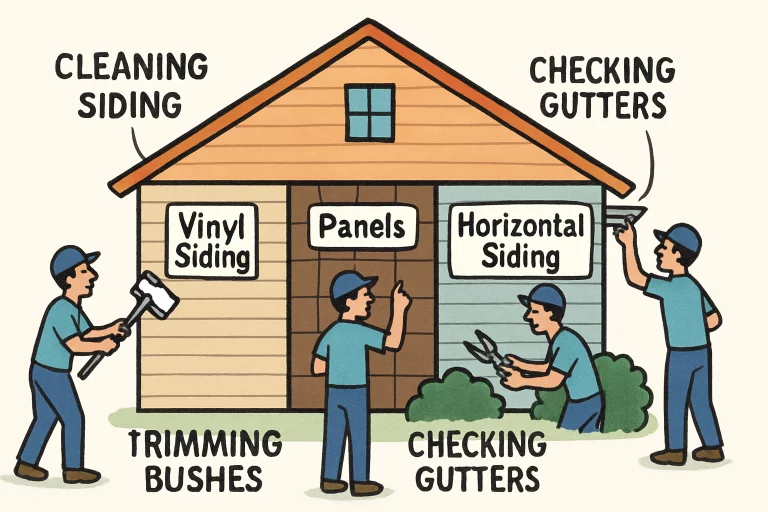Your home’s siding is far more than a decorative element—it’s a vital shield that guards your home against wind, rain, snow, pests, and the relentless wear of daily weather exposure. Ignoring its maintenance can leave your house vulnerable to a host of costly, avoidable problems. Whether you want to boost your property’s curb appeal or dodge expensive repairs down the road, a little proactive care truly pays off. Turning to specialized professionals in siding repair Denver can provide trustworthy expertise, especially for those who want the job done right the first time. Early and regular attention to your siding’s health not only circumvents major repairs but also preserves and even boosts your home’s market value. Understanding the essential steps in siding maintenance is a powerful way to take control as a homeowner. When you know what to look for and how to address issues, you can respond rapidly, keeping your house a source of pride and security for years. Below, you’ll discover a comprehensive maintenance guide, packed with practical advice and professional recommendations for prolonging siding lifespan. These tips are tailored to a variety of siding materials, so you can deliver the best care no matter what’s protecting your house.
Regular Cleaning: The First Line of Defense
The accumulated effects of dirt, grime, and mildew do more than simply mar the appearance of your home; they can actively degrade your siding, reducing its protective qualities and potentially leading to damage that is expensive to repair. Establishing an annual cleaning routine is essential, but homes situated near trees, busy roads, or in damp climates may require more frequent attention. For vinyl siding, use a soft-bristled brush and a gentle soap-and-water solution. Work in manageable sections, rinsing thoroughly to prevent soapy residue that could attract more grime. Wooden siding is more delicate and should be handled with specialty wood cleaners, ensuring any harsh residues are fully removed. It’s crucial to approach cleaning with caution. High-powered pressure washers, while tempting, can gouge soft materials or drive water up under the siding, causing insidious damage you may not notice until much later. Cleaning from the bottom up helps avoid unsightly streaks, and it’s wise to treat the process as an informal inspection—look for cracks, holes, or warped areas as you work, and note anything that merits follow-up. Preventing dirt and mildew buildup not only supports long-term siding performance but also keeps your home looking its best in every season.
Bi-Annual Inspections: Catching Issues Early
Consistent, attentive inspections—ideally conducted each spring and fall—form the backbone of any effective siding maintenance plan. These checks let you pinpoint developing issues before they spiral into major repairs. Walk around your home and pay close attention to siding panels near windows, doors, and rooflines, as these are common entry points for water. Look for warning signs such as cracks, chips, loose panels, or areas where boards appear warped, bubbled, or sagging. Pay particular attention to discoloration, fading, or bubbling paint, especially in wood or fiber cement siding, as these often hint at moisture trapped behind your siding—a problem that can quickly escalate to rot, mold growth, and insulation damage. Beyond visible surface issues, don’t forget to examine the integrity of sealants and caulking around joints and seams. If you find gaps, crumbling, or peeling, swift repair will keep water—and pests—from making their way inside your walls, safeguarding your investment for years to come.

Sealing and Painting: Protecting Against the Elements
Painting and Re-Sealing Tips
Protective coatings, whether paint or specialty sealant, are your siding’s armor against harsh weather. Over time, sunlight’s ultraviolet rays, strong winds, rain, and snow will break down this barrier, leaving your siding exposed. Most wood sidings benefit from a fresh coat of paint or sealant every three to five years, though your home’s specific needs will depend on its location and the elements it faces. Always prepare for painting by cleaning and thoroughly drying the siding. Use only high-quality, exterior-grade paints or sealants formulated to resist UV degradation. Not only do these products preserve vibrant colors and a fresh appearance, but they also protect against ruined finishes, warping, and pest intrusion. For composite, engineered, or specialty sidings, check the manufacturer’s guidelines for compatible coatings to ensure a durable, lasting finish.
Managing Vegetation: Preventing Physical Damage
Lush landscaping complements any home, but unmanaged vegetation can become a hidden menace to your siding. Trees, bushes, and even climbing vines that grow too close can physically scratch, gouge, or rub away protective layers. When leaves and branches remain in constant contact, they trap moisture against the siding, creating ideal conditions for mold, algae, and decay. Stay vigilant by trimming all greenery back at least 6 to 12 inches from the siding, making sure there’s enough airflow to help keep surfaces dry. Check that flower beds near your home are graded away from the foundation to prevent water from accumulating near the walls. These simple modifications are powerful ways to deter long-term damage and maintain a healthy, attractive exterior—all without sacrificing your landscape’s beauty.
Professional Evaluations: Leveraging Expertise
While regular homeowner inspections are indispensable, inviting a professional’s keen eye provides an additional layer of confidence for protecting your investment. Professionals employ industry knowledge and specialized tools to find hidden flaws—such as moisture penetration, pest damage, warped panels, or slowly spreading rot—long before these issues are detectable from the outside. Their expertise allows them to recommend the most effective maintenance schedule and pinpoint emerging vulnerabilities. Whether you are unsure about a suspicious patch or just want periodic peace of mind, hiring a reputable siding specialist ensures accurate diagnosis. These experts will help you decide between spot repairs and full replacement only when absolutely necessary, helping you avoid both needless spending and worsening deterioration.
For an even more in-depth resource on siding maintenance, or to connect with trusted specialists in your area. Their experienced team can provide tailored solutions to address your exact siding material and climate conditions.
Addressing Repairs Promptly
Even the smallest visible defect—a hairline crack, a minor gap, or a loose panel—is your cue to act quickly. Left unaddressed, these little problems inevitably widen over time, allowing moisture, insects, or even rodents a direct path into your wall assemblies. Use high-quality, exterior-grade caulk or patching compounds to address minor gaps or holes as soon as you spot them. For more complex issues, such as multiple shifting panels or larger cracks, it’s often safer and more cost-effective to call a professional repair service to properly reinstall or reinforce your siding. Procrastination rarely pays off in career advancement. Water intrusion through damaged sections can quietly undermine your home’s structure, lead to health-threatening mold, rot framing lumber, or destroy insulation quality. Prompt action is the simplest way to keep your siding sealing out the elements and your walls entirely secure.
Preventing Moisture Damage
Gutter and Drainage Maintenance
Water is one of siding’s greatest adversaries, but controlling its path begins above the siding itself. Gutters and downspouts are your home’s first defense against moisture-related damage. Check and clean gutters regularly, removing leaves, twigs, and debris that can create blockages or cause water to spill down siding panels. Inspect for leaks, rust, or sections sagging away from the roofline, and address any issues promptly.
Downspouts should direct water several feet away from your foundation and lower siding, minimizing the risk of ponding or slow drainage that can soak walls. While inspecting, look closely at all siding joints, seams, and cutouts for small cracks or signs of gapping. Seal up any vulnerabilities proactively, and verify that all landscaping and surfaces direct run-off water away from your home’s perimeter for optimal protection. Diligent drainage maintenance is a straightforward yet essential way to defend your siding and home for decades to come.
Conclusion
With a consistent, intentional approach to siding care, your home’s exterior will retain both its protection and beauty for many decades. Routine cleaning routines, regular do-it-yourself inspections, and prompt, quality repairs are all straightforward steps that prevent premature aging, unexpected expenses, and long-term issues. Remember, investing a modest amount of time and attention—and accessing professional expertise when needed—will keep your siding resilient, your home protected, and your peace of mind intact.

